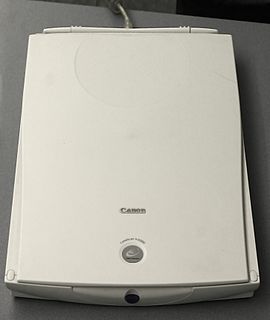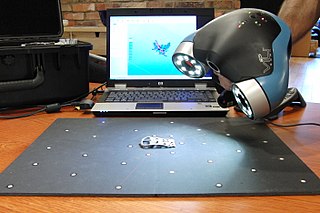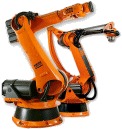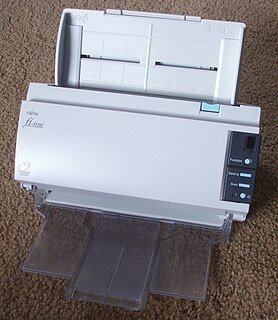
A barcode or bar code is a method of representing data in a visual, machine-readable form. Initially, barcodes represented data by varying the widths and spacings of parallel lines. These barcodes, now commonly referred to as linear or one-dimensional (1D), can be scanned by special optical scanners, called barcode readers, of which there are several types. Later, two-dimensional (2D) variants were developed, using rectangles, dots, hexagons and other patterns, called matrix codes or 2D barcodes, although they do not use bars as such. 2D barcodes can be read using purpose-built 2D optical scanners, which exist in a few different forms. 2D barcodes can also be read by a digital camera connected to a microcomputer running software that takes a photographic image of the barcode and analyzes the image to deconstruct and decode the 2D barcode. A mobile device with an inbuilt camera, such as smartphone, can function as the latter type of 2D barcode reader using specialized application software.
e-text is a general term for any document that is read in digital form, and especially a document that is mainly text. For example, a computer-based book of art with minimal text, or a set of photographs or scans of pages, would not usually be called an "e-text". An e-text may be a binary or a plain text file, viewed with any open source or proprietary software. An e-text may have markup or other formatting information, or not. An e-text may be an electronic edition of a work originally composed or published in other media, or may be created in electronic form originally. The term is usually synonymous with e-book.

An MFP, multi-functional, all-in-one (AIO), or multi-function device (MFD), is an office machine which incorporates the functionality of multiple devices in one, so as to have a smaller footprint in a home or small business setting, or to provide centralized document management/distribution/production in a large-office setting. A typical MFP may act as a combination of some or all of the following devices: email, fax, photocopier, printer, scanner.

A barcode reader is an optical scanner that can read printed barcodes, decode the data contained in the barcode and send the data to a computer. Like a flatbed scanner, it consists of a light source, a lens and a light sensor translating for optical impulses into electrical signals. Additionally, nearly all barcode readers contain decoder circuitry that can analyze the barcode's image data provided by the sensor and sending the barcode's content to the scanner's output port.

An image scanner—often abbreviated to just scanner—is a device that optically scans images, printed text, handwriting or an object and converts it to a digital image. Commonly used in offices are variations of the desktop flatbed scanner where the document is placed on a glass window for scanning. Hand-held scanners, where the device is moved by hand, have evolved from text scanning "wands" to 3D scanners used for industrial design, reverse engineering, test and measurement, orthotics, gaming and other applications. Mechanically driven scanners that move the document are typically used for large-format documents, where a flatbed design would be impractical.
Optical mark recognition is the process of reading information that people mark on surveys, tests and other paper documents.

Logistics automation is the application of computer software or automated machinery to improve the efficiency of logistics operations. Typically this refers to operations within a warehouse or distribution center, with broader tasks undertaken by supply chain engineering systems and enterprise resource planning systems.

Scanner Access Now Easy (SANE) is an application programming interface (API) that provides standardized access to any raster image scanner hardware.

A film scanner is a device made for scanning photographic film directly into a computer without the use of any intermediate printmaking. It provides several benefits over using a flatbed scanner to scan in a print of any size: the photographer has direct control over cropping and aspect ratio from the original, unmolested image on film; and many film scanners have special software or hardware that removes scratches and film grain and improves color reproduction from film.

3D scanning is the process of analyzing a real-world object or environment to collect data on its shape and possibly its appearance. The collected data can then be used to construct digital 3D models.
A planetary scanner is a type of image scanner for making scans of rare books and other easily damaged documents. In essence, such a scanner is a mounted camera taking photos of a well-lit environment. Originally, such scanners were expensive and could only be found in archives and museums, but with the availability of cheap, high-resolution digital cameras, DIY planetary scanners have become affordable, and for instance are being used by volunteer scan providers for Project Gutenberg.

An automated guided vehicle or automatic guided vehicle (AGV), also called autonomous mobile robot (AMR), is a portable robot that follows along marked long lines or wires on the floor, or uses radio waves, vision cameras, magnets, or lasers for navigation. They are most often used in industrial applications to transport heavy materials around a large industrial building, such as a factory or warehouse. Application of the automatic guided vehicle broadened during the late 20th century.

In multifunction or all-in-one printers, fax machines, photocopiers and scanners, an automatic document feeder or ADF is a feature which takes several pages and feeds the paper one page at a time into a scanner or copier, allowing the user to scan, and thereby copy, print, or fax, multiple-page documents without having to manually replace each page.
Duplex printing is a feature of some computer printers and multi-function printers (MFPs) that allows the printing of a sheet of paper on both sides automatically. Print devices without this capability can only print on a single side of paper, sometimes called single-sided printing or simplex printing.

Book scanning or book digitization is the process of converting physical books and magazines into digital media such as images, electronic text, or electronic books (e-books) by using an image scanner.

A photocopier is a machine that makes copies of documents and other visual images onto paper or plastic film quickly and cheaply. Most modern photocopiers use a technology called xerography, a dry process that uses electrostatic charges on a light-sensitive photoreceptor to first attract and then transfer toner particles onto paper in the form of an image. The toner is then fused onto the paper using heat, pressure, or a combination of both. Copiers can also use other technologies, such as inkjet, but xerography is standard for office copying.

Quantapoint, Inc. is a technology and services company that develops and uses patented 3D laser scanning hardware and software. Quantapoint creates a Digital Facility using 3D laser scanning and then provides visualization, analysis, quality control, decision support and documentation services for buildings, museums, refineries, chemical plants, nuclear and fossil-fuel power plants, offshore platforms and other structures.
Amavis is an open-source content filter for electronic mail, implementing mail message transfer, decoding, some processing and checking, and interfacing with external content filters to provide protection against spam and viruses and other malware. It can be considered an interface between a mailer and one or more content filters.
Apple's OneScanner was a series of flatbed scanners introduced during the early 1990s. The original OneScanner model was introduced in 1991 to replace the earlier Apple Scanner, offering 8-bit greyscale scanning. It was joined by the Color OneScanner the next year, and a series of updated models followed. The series culminated with the Color OneScanner 1200/30, with a resolution of 600x1200 dpi and 30-bit color scanning. The 1200/30 included options for automatic page feeding and scanning transparent materials. The entire OneScanner series used SCSI as its primary interface. Sales of the final 1200/30 model ended in 1997.
The DIY Kindle Scanner, or Do It Yourself Kindle Scanner, is a robotic device made from Lego Mindstorms which was designed and built by Peter Purgathofer from 2012 to 2013. The robot interfaces with Purgathofer's personal computer and a Kindle to make a copy of the Kindle e-book. This robot in effect bypasses the digital rights management system set in place to protect Kindle e-books.












